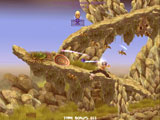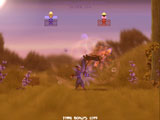|
Rag Doll Kung Fu is a mostly solo effort by Mark Healey, a former Lionhead artist (who has since founded Media Molecule with other Lionhead veterans). RDKF is a very impressive production; especially considering that Mark made the jump from artist to programmer in order to implement his vision. The visuals are fantastic, the cut scenes are consistently quirky, and the overall production quality is top-notch. But how does it stack up as a physics game? Well, read on… Puppet PhysicsThe control paradigm in Rag Doll Kung Fu is best described as puppetry. Your character will stand under his own power, and you click and drag appendages to move him around. The feet stick to the ground with a breakable force; lead left or right and the feet will unstick and swing forward. This results in a great impression that the character is reluctantly following your cursor. To strike, you right-click on any limb and drag it towards your intended target. Upon release of the mouse button your character unleashes a kick/punch/head butt/whatever. Any weapon in your hand will automatically connect; all you have to do is flail. Precision Mousing RequiredWhere Rag Doll Kung Fu falls down, in my opinion, is its requirement for very precise mouse movements. If you want to kick something you need to find and click on one of your feet. In the midst of battle, and because the default camera behavior is to auto zoom out, that can be rather tricky. This is exacerbated by the fact that the game forces you to constantly move the mouse (you need to move the mouse in tiny circles to constantly power up your chi). The end result is that the mouse cursor is all over the place. I have a really hard time getting into the flow of a RDKF game because of this. Other character-based physics games, like Ragdoll Masters and Ski Stunt Simulator, implement tighter, more 1-to-1 control of your character. I much prefer direct contract as compared to Rag Doll Kung Fu’s point-and-drag interface. The learning curve may be more obvious when you can simply click on what exactly you’d like to move, but for me the skill ceiling is much, much lower. My skill as a player doesn’t improve much, so I’m still fumbling around as much after a few hours of play as I was when I first picked the game up. 

(Rag Doll Kung Fu Game Screenshots)
Content and ProductionIt’s worth noting that despite RDKF’s flaws as a physics game, the overall experience—when you take into account the cutscenes, production polish, and available minigames—is definitely worth your dollar. The game looks absolutely gorgeous, with a lot of obvious drug references and influences. The slowdown mushroom effect is great. The cutscenes are strange, and depending on your sense of humor you’ll probably be delighted or irritated by them. A Disappointing Physics GameAt the end of the day, though, I’m not that impressed with Rag Doll Kung Fu as a physics game. I was really looking forward to it, too, after I heard such amazing things following its demo at the Experimental Gameplay Workshop in 2005. There are just too many barriers getting in the way of meaningful, controlled player movement. My RDKF experience usually looks like puppets spazzing out, and that’s not very satisfying or very replayable. Download Rag Doll Kung Fu Game The full version of Rag Doll Kung Fu is available for $14.95 on Steam (a demo is also available). |